Chornobyl Report
A monthly update of Chornobyl support activities for July 30, 1999
DOE Deputy Secretary visits Ukraine with U.S. Ambassador
Report available on German and French activities at Chornobyl
Ukraine's education system joins the GLOBE program
Glauthier commemorates International Radioecology Laboratory
Contractor selected for heat plant
Pioneer robot makes debut at Chornobyl Shelter
Terry Lash receives citizenship award
Shelter safety tasks completed
Trade conference part of trip to Ukraine
Update on EBRD/Nuclear Safety Account Project Management Unit activities
Survey activities to be completed by November
Book project update
Baseball arrives in Slavutych
DOE Deputy Secretary visits Ukraine with U.S. Ambassador
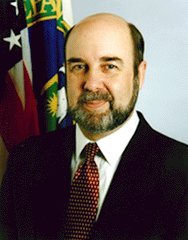 T.J. Glauthier represented the United States in Ukraine at a conference in Kharkiv and tour of Chornobyl. |
The Ukraine trip included a tour of the operational Unit 3 at the Chornobyl Nuclear Power Plant (NPP) and a visit to the Chornobyl Shelter site. Glauthier also toured various scientific, educational, and cultural facilities in Slavutych. While there, he received briefings on several programs under DOE direction. In addition, Glauthier and U.S. Ambassador to Ukraine Steven Pifer represented the United States at the U.S.-Ukraine Energy Trade and Investment Conference in Kharkiv.
Accompanying Glauthier and Ambassador Pifer were Rose Gottemoeller, DOE Assistant Secretary for Nonproliferation and National Security; Terry Lash, DOE Director of the Office of International Nuclear Safety and Cooperation; Terry Fariello, DOE Deputy Assistant Secretary for Policy; and Carol Kessler, U.S. Department of State Senior Coordinator for Nuclear Safety.
This issue of the Chornobyl Report includes some of the highlights of Glauthier's visit to Slavutych and Chornobyl. Additional photographs of the visit can be found on the International Nuclear Safety Program Internet site at https://insp.pnnl.gov:2080/?library/new_photos.
Report available on German and French activities at Chornobyl
The initial project of the German-French Initiative for Chornobyl recently completed its first year. The purpose of the Safety State of the Chornobyl Sarcophagus project is to collect, analyze and verify existing data describing the current safety of damaged Unit 4.
The project is being conducted by Gesellschaft für Anlagen und Reaktorsicherheit (GRS) mbH of Germany and the Institut de Protection et de Sureté Nucleaire (IPSN) of France.
Contractors working on the project include the State Scientific Research Institute of Building Constructions, Kyiv; Chornobyl Nuclear Power Plant (NPP) and Object Shelter management; the Interdisciplinary Scientific and Technical Center; and the Kurchatov Institute, Moscow, Russia.
Areas of investigation include:
building construction - pre- and post-accident geometric dimensions and design, load-bearing capacity, material parameters, and other damage
radiological situation and equipment - radiation fields, contamination levels, radiological protection aspects, systems, components, measuring devices, instrumentation, fire loads, and other equipment
nuclear fuel and radioactive waste - remaining fuel elements, fragments of active zone, fuel-containing masses, fuel dust, radioactive water solutes, and contaminated materials
environmental impact - radiation fields and contamination levels at the Shelter, including radioactive concentration in the air, soil, and groundwater
database configuration - provision of electronic means (software and hardware), establishment of the structure of the database, interfaces to the contractors, data input.
The International Chornobyl Center is providing administrative support and establishing appropriate documentation. The Center will maintain the database once the project is completed.
An expert team under the guidance of Atomaudit, Kyiv, will provide external data and content quality management. Geomatics International, in cooperation with GRS, will provide external quality control of the database configuration, data transfer, and installation of the system at the Center and GRS/IPSN facilities.
A comprehensive description of the project may be found on the GRS Internet site at www.grs.de/frambote.htm. Click on "Publications" section. The report is titled, The French-German Initiative for Chornobyl.
Ukraine's education system joins the GLOBE program
On May 27, Ukraine joined 82 other countries as members of the GLOBE program for students, educators, and scientists. GLOBE, which stands for Global Learning and Observations to Benefit the Environment, is an international science and education program started in the United States by Vice President Al Gore in 1994.
An official signing ceremony for the GLOBE agreement between Ukraine and the United States was held at one of the Slavutych schools during Deputy Secretary Glauthier's visit. Steven Pifer, U.S. Ambassador to Ukraine, and Dmytro Bechev, Ukrainian Head of the Department of Secondary Education, Ministry of Education, signed the document in front of a large gathering of U.S. and Ukrainian government officials, Slavutych community leaders, Peace Corps representatives, local students, and news media.
"Through support from the Peace Corps' Mission in Ukraine and the U.S. Department of Energy, schools such as those in Slavutych will soon be able to join other students and teachers around the world in learning about and improving the environment," said Ambassador Pifer. "As part of the GLOBE program, students from kindergarten to high school will help scientists by regularly taking environmental measurements of the soil, air, and water and publishing their data via the Internet on the World Wide Web," said Pifer.
Several of the Slavutych students who will be involved in GLOBE activities joined Deputy Secretary Glauthier in opening an electronic mail message from Vice President Gore (reprinted below) welcoming them to the GLOBE program. Together, the students and Glauthier also drafted a note of thanks back to the Vice President.
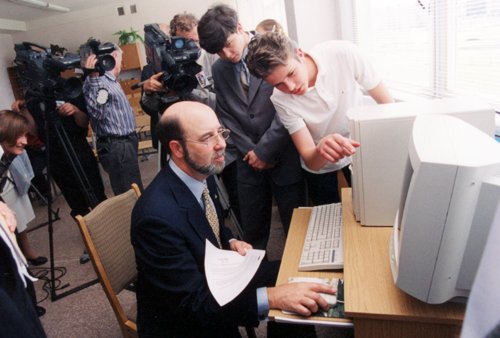 DOE Deputy Secretary Glauthier opens an electronic message from Vice President Al Gore to Slavutych students offering congratulations on Ukraine becoming the newest member of the GLOBE program. |
|
WASHINGTON Dear Friends: I am honored to take this opportunity to welcome the students and teachers of Slavutych who are joining the GLOBE program. While I regret not being able to join you in person, I do want to extend my best wishes for a successful and productive event. We are delighted that a Slavutych school is the first in Ukraine to join the GLOBE program. This marks the entry of Ukraine into a worldwide network of students, teachers and scientists who are working together to study and understand the global environment. Students and teachers from 6,800 schools in more than 80 countries are working with research scientists through the GLOBE program to learn about and to further public understanding of our planet. GLOBE, which stands for Global Learning and Observations to Benefit the Environment, has three major goals:
By collecting GLOBE data, the students and teachers of Slavutych will have unique and valuable information to share with countries worldwide, and will build an understanding of the ecosystems, lifestyles, and cultures of other nations. Ultimately, they will learn a powerful lesson: that the Earth is a system and that what happens in one part of the world can have important effects elsewhere. Please accept my best wishes for all of you during this special occasion, along with my warmest hopes for continuing success in your lifelong education. Sincerely, Al Gore |
Glauthier commemorates International Radioecology Laboratory
DOE Deputy Secretary T.J. Glauthier commemorated the construction and future operation of the International Radioecology Laboratory (IRL) at a ceremony in Slavutych on May 27. Several people instrumental in establishing the laboratory also were present. They included Robert Baker, Horn Professor of Biology, and Carlton Phillips, Chairman of Biological Sciences, Texas Tech University; and Ron Chesser, Professor of Genetics, University of Georgia, who directs IRL research programs. Mikhail Bandarkov, the recently named director of IRL, also participated in the ceremonial activities.
"It is important that scientific research be conducted in the polluted regions near Chornobyl to document and understand the environmental impacts of this disaster and to predict the environmental consequences of future radioactive releases," said Glauthier. "The International Radioecology Laboratory will provide a focal point for scientists from around the world to evaluate the legacy of the world's worst nuclear accident," he said.
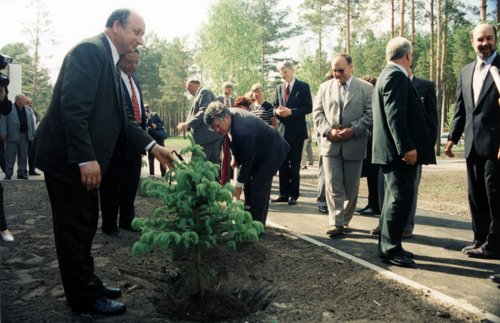 Dr. Terry Lash, Director of DOE's Office of International Nuclear Safety and Cooperation, helps plant a tree at the International Radioecology Laboratory while Chornobyl NPP Director General Tolstonogov (left foreground) and other dignitaries look on. The tree was one of three planted to commemorate the construction and future operation of the laboratory. |
The IRL was established by agreement between the governments of Ukraine and the United States. Construction is to be completed by end of the year. The laboratory includes the main facility in Slavutych and a sample-processing laboratory in the town of Chornobyl.
In the Chornobyl exclusion zone, animals and plants spend their entire life cycles in one of the most radioactively contaminated sites on earth. Glauthier said that the accident at Chornobyl on April 26, 1986, left a legacy that needs to be studied to learn about the long-term risks of radioactive materials released into the environment.
Scientists from Ukraine, the University of Georgia, and Texas Tech University have been involved in cooperative research in the Chornobyl region since 1992. Currently, DOE and the University of Georgia provide most of the laboratory's funding.
In addition to finding answers to questions about the effects of the Chornobyl accident, the laboratory serves another purpose. Work at the new laboratory will help provide badly needed jobs in the Slavutych area.
Most of the 28,000 Slavutych residents are dependent, in some way, on support from the operation of Chornobyl NPP. Three reactors at Chornobyl are closed and the fourth is scheduled to be shut down in the year 2000. The laboratory is part of the planned diversification of the Slavutych economy.
A joint committee will oversee management of the IRL. Committee members are specialists from the Ukraine Ministry of Emergency Situations and Affairs of the Protection of the Population from the Consequences of the Chornobyl Nuclear Accident, the International Chornobyl Center, and University of Georgia's Savannah River Ecology Laboratory.
Contractor selected for heat plant
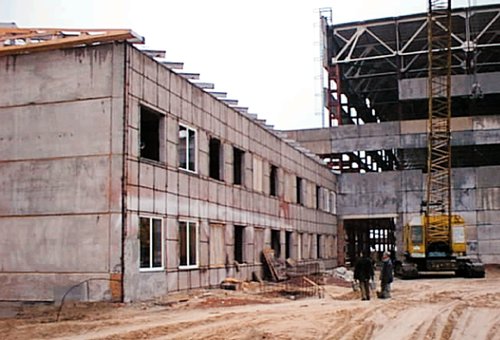 Windows were recently installed in the Replacement Heat Plant Administration Building. |
A general contractor for the Chornobyl heat plant completion project was selected from among two proposals in early May. Negotiations to finalize the contract are in progress. The contract is expected to be signed and the contractor announced by August 1999. Several other contracts were executed, including
construction of heat and other service piping and trestle upgrade
final design
electrical testing and adjustment of administrative building
boiler components, instrumentation, and controls
Substantial progress has been made on completion of the Administrative building as well as the underground water and other services, including a fire protection ring. None the less, much remains to be done in a relatively short period of time.
Pioneer robot makes debut at Chornobyl Shelter
 The Pioneer robot made its official debut during a general systems demonstration outside the Chornobyl Shelter observation building on May 27. Attending the demonstration were (left to right) T.J. Glauthier, DOE Deputy Secretary; Steven Pifer, U.S. Ambassador to Ukraine; Joseph Herndon, Oak Ridge National Laboratory; Bruce Thompson, RedZone Robotics, Inc.; an interpreter; Vitaliy Tolstonogov, Chornobyl NPP Director General; and Volodymyr Kholosha, First Deputy Minister of Emergency Situations. |
In late December 1998, the United States shipped a radiation-hardened robot to Ukraine for possible use in reconstructing the shelter over damaged Unit 4. Named "Pioneer," the robot ultimately may be deployed to collect visual and physical data in areas too contaminated for human access. Development of Pioneer was a collaborative effort involving U.S. companies, national laboratories, and universities.
After several weeks of shakedown and training, Pioneer made its official debut at the Shelter site on May 27. The demonstration was held in conjunction with DOE Deputy Secretary Glauthier's visit to Chornobyl NPP. At the conclusion of the demonstration, Glauthier was presented with the controls and tried his hand at manipulating the robot.
DOE and the National Aeronautics and Space Administration provided funding for Pioneer with development support from Carnegie Mellon University's (CMU) National Robotics Engineering Consortium. RedZone Robotics Inc. of Pittsburgh, Pennsylvania, built the robot. Oak Ridge National Laboratory (ORNL) staff manage the Pioneer project and serve as technical coordinators for the work. Lawrence Livermore National Laboratory had been involved in the early development of the robot.
Testing of Pioneer was conducted in May in accordance with the program plan, "Pioneer System Cold Testing and Preparing for Demonstration at Shelter Object," developed by the Shelter Object organization and approved by ORNL.
During the training and nonradioactive test activities, ORNL, RedZone, and CMU had substantial interaction with staff of the Unit 4 Shelter and Interbranch Scientific and Technical Center (ISTC). Those specialists extensive reviewed the Pioneer documentation.
Terry Lash receives citizenship award
 Slavutych Mayor Volodymyr Udovychenko presented an honorary citizenship award to "our friend and brother from the United States, Dr. Terry Lash." The award is given each year to a person who has made a "personal contribution to city development." The awards are presented on the anniversary of the founding of Slavutych. Lash was chosen to receive this year's award to acknowledge the close cooperation between Ukraine and the United States on international projects vital to the future of Slavutych. |
Shelter safety tasks Completed
Three of the four tasks in the Shelter Worker Safety Project have been completed. The completed tasks are neutron monitoring, dust suppression, and industrial safety. The remaining task, dose reduction, is on schedule to be completed by the end of September 1999.
A team from Pacific Northwest National Laboratory, including contractor staff from Delphinus Engineering Inc., visited Chornobyl in late April to install equipment and provide training on software for dosimetry systems recently released by Ukrainian Customs. In addition, agreements were reached on installing upgrades to the local area network at the Shelter, now in progress. Meetings were held in Kyiv with the Nuclear Regulatory Administration and State Scientific and Technical Center to discuss opportunities for future collaboration on regulatory issues.
Trade conference part of trip to Ukraine
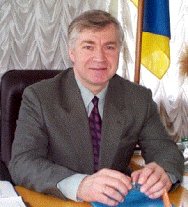 Governor Oleg Dyomin, Head of the Kharkiv Regional State Administration, hosted the U.S.-Ukraine Energy Trade and Investment Conference.. |
The event was held as follow-up to the November 1998 U.S.-Ukraine Conference on Nuclear Trade and Cooperation in Washington, D.C. Both events were organized to introduce U.S. corporations and firms to Ukrainian energy companies and institutes to expand business opportunities and promote commercial partnerships.
Several joint statements were signed and grants awarded at the conference in Kharkiv last month. The following information, provided by DOE, summarizes actions taken in conjunction with the conference:
Exchange of Diplomatic Notes on Agreement of Peaceful Nuclear Cooperation ("1-2-3 Agreement") - Through an exchange of notes, the United States and Ukraine brought into force their Agreement on Peaceful Nuclear Cooperation. This important agreement marks the beginning of a new dimension in the U.S. nuclear partnership with Ukraine. The U.S. and Ukraine will be embarking on the Nuclear Fuel Qualification Program to enable Ukraine to diversify its suppliers for nuclear fuel. The United States expects to provide $10 million for this project in FY 2000, with additional funding in future years. In addition, the option of alternative sources of nuclear fuel will save Ukraine millions of dollars over time. The agreement will open the door to other such concrete commercial projects between U.S. and Ukrainian companies.
U.S. Department of Energy Grant Awarded to Alliance to Save Energy - The U.S. Department of Energy awarded a $75,000 grant to the Alliance to Save Energy to develop a steam energy efficiency initiative in Ukraine. The U.S. Department of Energy has also selected the Alliance to Save Energy for the first-year funding of $100,000 for a cooperative agreement to promote sustainable energy service companies in Ukraine. Second-year funding of $75,000 is anticipated pending successful results in the first year's work.
U.S. Government Grant Awarded to Motorola/Kommunar - The U.S. Government announced the decision to award a $300,000 Department of Defense Cooperative Threat Reduction grant to Motorola to form a defense conversion joint venture with Kommunar to assemble two-way radios in Kharkiv. This announcement supports the State Department's Kharkiv initiative to expand business opportunities in Kharkiv.
Joint Statement on Expanded Cooperation in Energy Fields - The U.S. Department of Energy and the Ministries of Energy and Power of Ukraine announced intensified cooperation in energy efficiency, conservation, transmission, distribution, and modernization through market economies. New projects are expected in areas such as clean energy technologies, nuclear energy and nuclear safety technologies, development of domestic oil and gas resources, and nuclear accident response. The two organizations also announced that they would work to enhance Ukraine's energy security by improving the investment climate and strengthening the cooperative power market.
Joint Statement on Expanded Cooperation in the Field of Emergency Response and Remediation of the Consequences of the Chornobyl Nuclear Accident - The U.S. Department of Energy and the Ministry of Ukraine for Emergencies and Population Protection from the Consequences of the Chornobyl Disaster announced intensified cooperation to prepare for and respond to radiological accidents including assessment of radiological contamination in plants, animals, humans, and the development of technologies for remediation of contaminated territory. The new cooperation will include expanded research collaboration through the International Radioecology Laboratory with facilities in Slavutych and the town of Chornobyl.
Joint Statement on Expanded Cooperation in Environmental Protection and Nuclear Safety - The U.S. Department of Energy and the Ministry of Environmental Protection and Nuclear Safety of Ukraine announced intensified cooperation in waste management, environmental protection, and nuclear reactor safety. New projects are expected in areas such as cleanup technologies for fossil plant effluents, diagnostic capabilities for chemical and radiological emergency response, risk analysis for national pipeline safety, and urban air quality monitoring and emissions standards. Activities are to include technical assistance, information exchange, and technical and economic feasibility studies.
Update on EBRD/Nuclear Safety Account Project Management Unit activities
The European Bank for Reconstruction and Development's Nuclear Safety Account project addresses preparation for closure of Units 1, 2 and 3 through two decommissioning facilities (liquid radioactive waste treatment and interim spent fuel storage as well as immediate safety measures at Unit 3 prior to closure.
Liquid Radioactive Waste Treatment Plant
Notification of contract award for the liquid radioactive waste treatment plant is scheduled for June. As a result of clarification meetings held after the first-stage tenders, second-stage tender documents were sent to each bidder in April. The submission date for the second-stage tender was May 7.
Interim Spent Fuel Storage Facility
The lowest-price tender for the interim spent fuel storage facility was evaluated and determined to meet the technical specification requirements. The final evaluation report will be completed pending resolution of contractual terms regarding taxes and duties exemption. Contract award is expected in June.
The Ministry of Environmental Protection and Nuclear and Radiation Safety has accepted the new site location. The Ministry of Emergency has provided verbal acceptance. The Cabinet of Ministers is expected to provide formal approval in June.
Safety improvement projects at Unit 3
All items except for the 6-kilovolt switchgears and personnel access control system have been supplied and are available on site. The inverters were installed and commissioned. Installation of the hydrogen monitoring system and vibration diagnostic equipment is under way and scheduled to be completed during the summer outage, along with the remainder of the items.
Survey activities to be completed by November
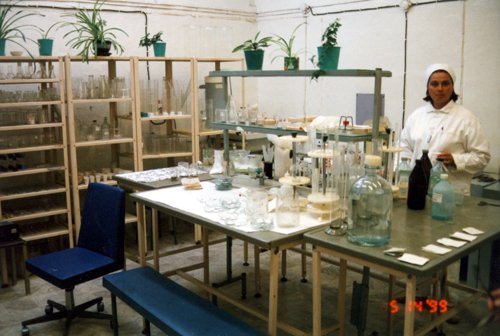 Samples collected are analyzed onsite at a Chornobyl Unit 3 analytical radiochemistry laboratory. |
Staff at Chornobyl Unit 1 began Comprehensive Engineering and Radiation Survey (CERS) activities in April. The objective of the survey is to define the radiological and operational status of Unit 1 systems and facilities to support decommissioning planning. The Chornobyl NPP chief engineer approved nearly all of the 114 working programs or procedures. To date, staff at Chornobyl NPP and the Slavutych Laboratory for International Research and Technology have completed survey activities on 13 plant systems. Survey activities are focused on systems in the Chemical Shop, Radiation Safety Shop, and Ventilation and Air Conditioning Shop. Physical surveys for the Unit 1 CERS are scheduled to be completed by November 1999.
Book project update
Hanford and Slavutych high school and middle school students working on a collaborative Hanford/Chornobyl book project have been extremely busy. At the Hanford School, students are gathering information for the book by interviewing community members who were removed from their land in the 1940s to make way for Hanford construction. They also have been interviewing scientists who worked on the Manhattan Project to construct the atomic bomb and scientists who now work on Hanford cleanup.
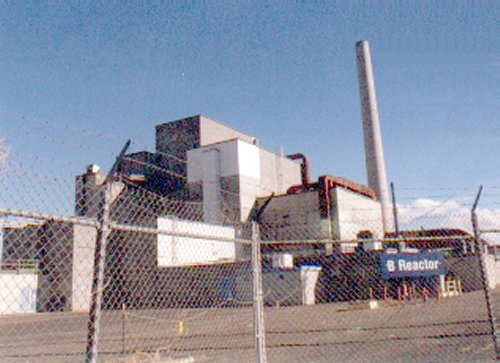 B Reactor was the United States' first plutonium production reactor. This photograph is one of many to be included in a book describing Hanford and Chornobyl past, present and future. |
The students in Slavutych are interviewing community members and scientists as well. They also are interviewing survivors of the Chornobyl accident. One of the survivors is Veronika Glukhova, formerly a student at Hanford High School. On May 2, 1999, her story was published in the newspaper that serves Richland, the Tri-City Herald. Veronica was six years old and lived in Ukraine when the accident occurred. Her father was a plant operator at the time, so she lived near the plant in a town called Prypyat, which was abandoned after the accident. Her story, as well as those of other Chornobyl survivors, will be included in the book on nuclear communities.
Bechtel Hanford Inc. provided most of the funding for the student book project.
Baseball arrives in Slavutych
While visiting Slavutych, DOE Deputy Secretary Glauthier and Slavutych Mayor Udovychenko dedicated the first baseball field in town by throwing out the first pitch. Glauthier also brought with him baseballs and baseball jerseys, courtesy of the Pittsburgh Pirates and Carnegie Mellon University.
The new field is the dream of Jeff Deal, a senior project manager based in Slavutych for DOE's Pacific Northwest National Laboratory (PNNL). Before Deal and his boys came to town, the children of Slavutych played soccer. Now they play baseball as well.
Thanks to Deal and his three sons, many Slavutych citizens are getting an education in the fine art of Little League baseball, U.S. style.
For the past year, Deal has been on special assignment in Slavutych, part of the joint project team of Battelle, Bechtel, and Electricite' de France that is providing safety improvements to the Chornobyl Shelter. He is responsible for managing project funds and setting up a common finance and business management structure for the three companies.
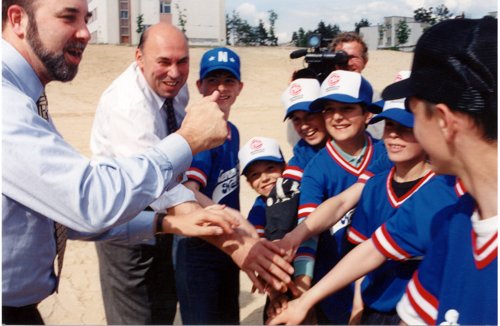 DOE Deputy Secretary Glauthier and Mayor Udovychenko join hands with Slavutych ballplayers to cheer the start of the first official baseball season at the new community field. |
Deal brought his love for baseball with him to this Ukrainian city whose population exists almost exclusively to run the Chornobyl plant. While working at PNNL in Richland, Washington, he also coached Little League ball in nearby Kennewick. Before moving his wife and sons to Slavutych, Deal decided he wanted to teach Ukrainian children how to play baseball.
Now they are shagging fly balls, swinging for the fences, and knocking down hot grounders as well as any American Little Leaguer.
"I gathered as much equipment as I could with the idea that we would start teaching my oldest son's friends the game of baseball. But after starting with just a few kids playing catch, soon we had at least 40 boys playing consistently."
Lack of equipment for the ball players is the number one obstacle, said Deal. "We had 20 kids and only 11 mitts. Many of the boys used their bare hands, and during drills we swapped gloves," he said. Help from the Deals' U.S. home is on the way. Colleagues at PNNL have been organized to gather baseball uniforms and equipment for the Ukrainian youngsters.
Besides lacking equipment, Jeff explained the "Bad News Bears of Slavutych" played baseball on a field laid out on a dry lake bed. "It gives the American term of 'sandlot baseball' a new meaning," he said.
More and more, the people of Slavutych are taking notice of Jeff and his family, and of what they are accomplishing. "After a meeting with the sports director of the city, he promised to provide two coaches and agreed to include a baseball diamond along with a new soccer field being built at the edge of town. We were also successful in getting several of the U.S. and foreign companies located here, such as Bechtel, to help build the new field."
Bringing baseball to Slavutych has been a family activity for the Deals. "We actually started setting up the team last year," Deal said. "Jeff Jr., who is 11, played and helped me coach. Russell, 6, was the batboy. Brendon, 8, and my wife Linda always lent support," he said.
Deal's assignment in Slavutych ends in the year 2000. Aside from sharing his love for baseball with the children of Slavutych, he said "I want to leave a small piece of America behind, and baseball is a positive and distinctly American legacy. The only thing missing is the hot dogs, peanuts, and Cracker Jacks."
See also Chornobyl Initiatives/General Information on Chornobyl and the Chornobyl Report Archive.